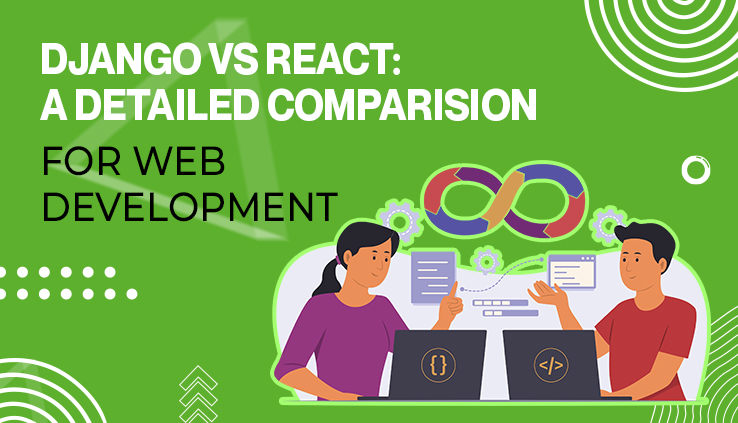Web development is constantly changing, so choosing the proper framework becomes a big deal. It is like the optical center that can either make or break the success of your digital projects. This article will address the most critical process of deciding between Django and React.
Django is a robust framework that makes the backend of websites easier using Python. Created by experienced developers, it handles many of the challenges in web development, allowing you to concentrate on building your app without starting from ground zero. It is free and open source. On the other hand, React is a frontend JavaScript library used for making dynamic and interactive UIs. This introduction sets the stage for a detailed comparison of Django vs React.
What is Django? And What Makes It So Unique?
Django is a robust web framework that’s all about Python. It’s known for being elegant and efficient, offering high-level tools that speed up web development—known for being very fast, taking security seriously, and handling high-level website traffic. It promotes the “Don’t Repeat Yourself” (DRY) principle and uses the Model-View-Controller (MVC) approach, which makes building applications smoother and more organized.
Features and Benefits
Django has handy features such as a database simplification tool (ORM), a user-friendly admin interface, and many reusable components. It strongly emphasizes security, protecting things like Cross-Site Request Forgery (CSRF) and SQL injection.
Places where Django Excels
Django excels in all those applications, industries, and management systems that rely on data—suited explicitly for fields that require security and adaptability, like publishing, financial technology, and the government.
Community Support and Resources
It offers surplus guides, tutorials, and add packages. This lively community encourages innovation and helps solve problems.
Drawbacks and Challenges
As everything has pros and cons, considering it to have a solid upper hand at the backend, Django, too, can face challenges in real-time applications regarding highly interactive frontends. The all-in-one structure might not be ideal for microservice architectures or projects with unfamiliar requirements.
What is React? Introduction to React as a JavaScript Library
In JavaScript libraries, React stands out as a prominent tool. Let us now explore what it is all about.
React as a JavaScript Library
Facebook developed React, a popular option for constructing lively, component-driven UIs. It uses a Virtual DOM and one-way data flow to enhance performance.
The Concept and Benefits
Components, JSX (JavaScript XML), and state management form the foundation of these frameworks. Such concepts make creating modular and reusable interfaces easier, making the development process more efficient.
Ideal Uses of React
Perfect for projects that need interactive UIs, like single-page applications (SPAs) and progressive web apps (PWAs). It excels when you need frequent updates and smooth user experiences.
React community and Ecosystem.
Backed by strong community support, React benefits from open-source contributions and third-party tools like Redux and React Router. The ecosystem fosters innovation and speedy development.
Drawbacks and Learning Curve
Although React has several benefits, it can be tricky to learn, especially for those new to its approach. Additionally, because React primarily concentrates on the visual aspect of applications, you might have to combine it with other tools and libraries for full-fledged web app development.
The above information gives a clear picture of how Django and React work, what areas they excel in, and their limitations. This knowledge helps the developers make well-informed decisions for their web development projects.
Django vs. React Difference
Let us see the fundamental differences between Django and React.
Based on Programming Language
Django uses Python for a robust backend, while React is in JavaScript and focuses on front-end user interfaces. Your choice depends on whether you prefer Python’s elegance or JavaScript’s versatility.
Architecture: Full Stack vs. Frontend
Django is an all-in-one full-stack framework, handling both the backend and front end, while React is explicitly designed for the front end. Your choice should depend on what your project’s architectural requirements are.
Scalability and Performance
Django scales well for complex applications, whereas React is excellent at high-performance front-end tasks. You should choose according to the specific scalable requirement of your project.
Learning Curve and Resources
Both Django and React have vital documentation and community support. The learning curve varies depending on your familiarity with Python or JavaScript.
User Interfaces
Django uses templates for frontend rendering, while React excels in component-based UI development. Choose based on your preference for templates or components.
Data Handling and APIs
Django simplifies database operations with its ORM, making it suitable for data-heavy apps. React excels when interacting with APIs, especially in single-page apps.
Security and Authentication
Django is known for its security features, including built-in authentication. React, as a frontend library, relies on backend systems for authentication.
SEO-Friendliness
Django supports SEO optimization out of the box with server-side rendering. React, a client-side library needs extra setup for SEO-friendly rendering.
Community and Support
Both Django and React have active communities and firm support. Your choice always comes down to your development team’s specific needs and preferences.
When to Opt for Django in Web Development
Let us now look at Django’s ideal places and perfect real-world uses.
Where Django Works Best
Django is the best option and handy for projects needing robust backend and frontend features. It is perfect for content management systems, online stores, and apps that use lots of data.
Django’s Potential
Learn the best methods for maximizing Django’s strengths, such as how to structure your applications, improve database queries, and use caching effectively.
When to Opt for React in Web Development
Let’s look at when React is the right choice and how to get the most out of it.
When is React the Right Choice?
React is perfect for projects requiring live user interfaces, real-time updates, and smooth user experiences. Check out when React’s component-based design works best.
Getting the Most from React in UI-Heavy Projects
Learn how to maximize React’s power in projects focusing on user interfaces. Get more insights on structuring components, managing data, and boosting performance.
Making Your Choice: Django, React, or Both?
How do you choose which option to go with and explore the potential of using either together?
Factors to Consider When Choosing Between Django and React
Let’s explore the key things that help you decide between Django and React. Your primary aim should be considering your project needs, the team’s skills, scalability, and how you want to build the project.
Case of Hybrid Approach
You could think of a scenario wherein you can make the most out of both frameworks. Think of an ideal situation where it can bring out a versatile and efficient web development process.
Conclusion
If you are looking to thrive in the web development world, there is no doubt that picking between Django and React is no less than an expert skill, given that each of them has its strengths that are ideal for different projects.
Be it Django or React Native, your choice should be based on a careful and detailed analysis of your project’s details. With the ever-evolving technology, combining the two is becoming more and more practical.
If you are looking for React native app web development services—partner with MMF Infotech Technologies, a top-notch web development company. Do not hesitate to hire web developers or dedicated experts with skills in these areas to bring your digital ideas to life.



